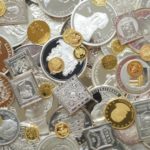Why Does The Fed Value Its Gold At $35 Per Ounce?
THANK YOU FOR POSTING A REVIEW!
Your review was sent successfully and is now waiting for our staff to publish it.

(November 19, 2023 - Mike Shedlock)
At $35 per ounce the Fed values its gold at $11.037 billion. What’s the gold really worth and why the low valuation?

The Fed’s gold marked to market at current price of $1984 per ounce. Calculation explained below.
The Fed has no oil to revalue but it does have gold. How much?
Fed’s Balance Sheet in Millions of Dollars

Fed’s balance sheet from the New York Fed, annotations by Mish
The price of gold at the time I created the lead chart was $1,984 per ounce. The lead chart shows the math involved to revalue the gold at that price.
The gold on the Fed’s balance sheet is worth about $625.6 billion. The Fed’s current balance sheet is $7.815 trillion so even revalued gold would be a tiny percent of the Fed’s assets.
Percentage of Fed’s Balance Sheet
- Current: (11,037 / 7,814,991) * 100 = 0.14 Percent
- Revalued: 625,640 / (7,814,991 – 11,037 + 625,640) * 100 = 7.42 Percent
Why Does the Fed Value Its Gold at $35 Per Ounce?
One pragmatic reason might be the Fed wants to avoid wild and random swings in the value of its balance sheet.
But the correct answer pertains to the Gold Reserve Act of 1934 as explained by Federal Reserve History.
Signed by President Franklin D. Roosevelt in January 1934, the Act was the culmination of Roosevelt’s controversial gold program. Among other things, the Act transferred ownership of all monetary gold in the United States to the US Treasury and prohibited the Treasury and financial institutions from redeeming dollars for gold.
Roosevelt’s gold program, which began in 1933, first restricted the private use of gold, requiring businesses like the Columbus firm to apply to the Fed for gold bars. The Gold Reserve Act of 1934 was the culmination of this program; President Roosevelt signed the Act on January 30, 1934.
Section 2 of the act transferred ownership of all monetary gold in the United States to the US Treasury. Monetary gold included all coins and bullion held by individuals and institutions, including the Federal Reserve. In return, individuals and institutions received currency at a rate of $35 per ounce of gold. This rate reduced the gold value of the dollar to 59 percent of the value set by the Gold Act of 1900, which equaled $20.67 per ounce. That rate had prevailed until the spring of 1933, when the Roosevelt administration began its campaign to devalue the dollar.
Sections 5 and 6 of the act prohibited the Treasury and financial institutions from redeeming dollars for gold, inverting the system that had prevailed in the United States since the nineteenth century. Under that system, the government converted paper currency to gold coins, whenever citizens desired to do so. Now, the government converted gold into dollars, regardless of whether citizens wanted to engage in the exchange.
Section 12 of the act authorized the president to establish the gold value of the dollar by proclamation. The president did this the day after he signed the act.
As an agent for the Treasury, the Federal Reserve executed Treasury policies, which included supplying dental manufacturing companies with gold to make false teeth.
Today, you might ask, do dentists still get gold from the Federal Reserve? No is the answer. The provisions of the Gold Reserve Act of 1934 applied to the stock of monetary gold in the United States at that time. The preponderance of that gold remains the property of the Treasury, although much of it physically resides in the vaults of the Federal Reserve Bank of New York.






